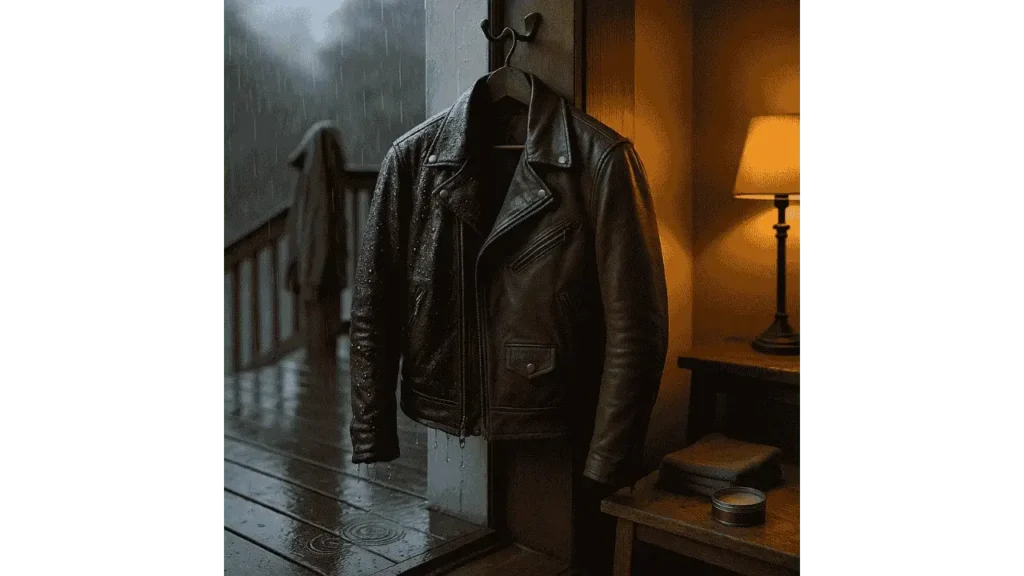Leather jackets are known for their toughness and timeless look, but if you’ve ever worn one in the rain, you’ve probably questioned just how waterproof they really are. I’ve owned several leather jackets over the years and worked with both treated and untreated types, and I can tell you this: leather has some natural resistance to water, but it is far from waterproof. If it gets soaked and you don’t treat it right away, you risk long-term damage.

Is Leather Naturally Waterproof?
Leather contains natural oils and dense fibers that offer limited moisture resistance, especially when the leather is new and has a tight grain. But leave a jacket in the rain too long, and it’ll start to soak up that water like a sponge. Once saturated, the structure weakens, causing the leather to stiffen, shrink, or crack over time. Expert leatherworking Daniel King points out,
“People often confuse water-resistance with waterproofing, but untreated leather will eventually absorb water if exposed long enough.”
How Well Do Leather Jackets Resist Water?
Effect of Leather Type on Water Resistance
The type of leather makes a big difference. Full-grain leather, with its dense, unaltered grain, offers the best water resistance among natural leathers. Top-grain leather, slightly more processed, often comes with a protective finish that helps repel moisture. In contrast, suede and nubuck absorb water very quickly due to their open, sanded surfaces. These finishes look great but need extra care in wet conditions.
How to Make a Leather Jacket More Water-Resistant?
Using Waterproofing Sprays and Waxes
Waterproofing sprays and waxes can make a noticeable difference. Sprays are lightweight and easy to apply, great for light rain protection. Waxes take more effort but offer stronger, longer-lasting resistance. I usually apply wax treatments once a season for jackets I wear frequently outdoors. According to leather care specialist Nina Lowe,
“The best protection comes from layering a quality wax with regular conditioning. It keeps the jacket flexible and ready for the elements.”
Conditioning for Extra Protection
Conditioners not only keep leather supple but also serve as a moisture shield. A well-conditioned jacket resists water better simply because its natural oils are replenished. Always apply conditioner before and after waterproofing treatments to help lock in moisture and preserve flexibility.
Proper Storage and Care
Proper storage keeps your jacket in shape and prevents water issues before they start. I always hang my jackets in a cool, dry place using a padded hanger. I avoid plastic garment bags and opt for breathable cloth covers. If a jacket gets even slightly damp, I let it air dry at room temperature, never near heat sources.
Can You Wear a Leather Jacket in the Rain?
Yes, but with limits. Light drizzle won’t ruin a properly treated jacket, especially if you’ve recently applied waterproofing spray or wax. But prolonged exposure, like walking for hours in heavy rain, is risky. If your jacket does get wet, gently blot off the water with a soft cloth, then let it air dry away from direct heat. Reapply waterproofing products afterward to maintain the barrier.
Learn More: How to Clean Mold Off a Leather Jacket?
Key Takeaways
Leather jackets are not naturally waterproof, but they can be made water-resistant with the right products and care. Regular conditioning, protective treatments, and smart storage all help extend your jacket’s life. And while it’s okay to wear one in light rain, always dry it properly and re-treat it afterward. With a little maintenance, your leather jacket will stay both stylish and resilient for years.
- How to Wear an Oversized Leather Jacket? Style Tips for a Casual Look - August 6, 2025
- How to Fold a Leather Jacket? - August 5, 2025
- How Should a Leather Jacket Fit a Woman? - August 1, 2025



